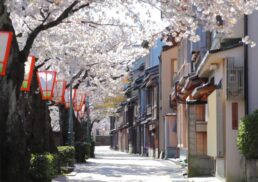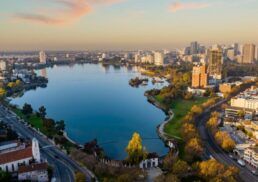Japan Kansai Airport, conveniently located near Osaka, is the main hub for travelers in the Kansai region. In this article, you’ll learn about the best transportation options to and from the airport, discover the facilities available to make your journey easier, and explore the unique features that distinguish Kansai Airport.
Table of Contents
Key Takeaways
Kansai International Airport is well-connected to the central region of Osaka through multiple transportation options, including train services like the JR Airport Express HARUKA and Nankai Airport Express, as well as various bus and taxi services.
The airport offers comprehensive facilities for travelers, including duty-free shops, restaurants, free Wi-Fi, and various amenities in its terminals, ensuring a comfortable experience for passengers.
Kansai International Airport faces significant engineering challenges due to its unique location on an artificial island, necessitating ongoing efforts to address sinking issues and enhance protections against extreme weather events like Typhoon Jebi.
Getting to Kansai International Airport

Kansai International Airport is strategically located 50 kilometers from the center of Osaka city, making it easily accessible by road, railway, and even high-speed ferry. Travelers have several convenient options to reach the airport, ensuring a smooth start to their journey. The primary modes of transportation include trains, buses, and taxis, each offering distinct advantages in terms of cost, speed, and comfort.
Ground transportation tickets can be purchased at the Kansai Tourist Information Center within the airport, providing added convenience for international travelers. In the following subsections, we will explore the specifics of each transportation method, starting with the efficient train services that connect major cities to Kansai Airport.
Train Service
For those who prefer the speed and reliability of rail travel, Kansai Airport offers several train services in Osaka Prefecture. The JR Airport Express HARUKA is a popular choice, connecting the airport to Tennoji, Osaka, and Shin-Osaka Stations. This train service is included in the JR Pass, making it a convenient option for tourists. The HARUKA also provides direct access to Kyoto Station, with a travel time of approximately 75 minutes. Passengers can enjoy reserved seating and a dedicated luggage storage area, enhancing their travel experience.
Another notable option is the Nankai Airport Express, which offers a premium service from Kansai Airport to Namba Station in Osaka. With plush seating and free Wi-Fi, this train ensures a comfortable journey in just 34 minutes.
For budget-conscious travelers, the Kansai Airport Rapid Service provides a more economical choice, connecting Osaka to the airport in about 65 minutes. The first trains from Osaka and Kyoto reach the airport early in the morning, around 6:00 and 7:00 respectively, accommodating early flights.
Bus Options
Bus services to Kansai Airport are extensive and cater to a wide range of travelers. The Airport Limousine Bus services connect the airport to major hotel districts such as Osaka Station, Kintetsu Uehommachi, and Namba Station, providing a direct and comfortable transfer option. These buses also serve neighboring prefectures, making it easy to reach destinations beyond Osaka.
Buses can be boarded from both Terminal 1 and Terminal 2, with tickets available at vending machines located on the first floor of each terminal. For those heading to central Osaka, direct buses depart from bus stop number 5 at Terminal 1 and bus stop number 1 at Terminal 2, ensuring a hassle-free journey to the heart of the city.
Taxi Services
Taxis are another viable option for reaching Kansai Airport, particularly for those who prefer a more private and direct mode of transportation. While taxis are readily available at the airport, they can be more expensive compared to other options. For instance, a taxi ride from Kansai Airport to Namba Station in central Osaka typically costs between ¥15,000 to ¥20,000.
The travel time for a taxi ride to Namba Station is approximately 50 minutes, depending on traffic conditions. Despite the higher cost, taxis offer the convenience of door-to-door service, making them ideal for travelers with heavy luggage or those arriving late at night when other transportation options may be limited.
Transportation from Kansai Airport
Once you’ve arrived at Kansai Airport, getting to your final destination is straightforward, thanks to the variety of transportation options available. Whether you’re heading to central Osaka, Kyoto, or even Kobe Airport, there are efficient services to suit your needs. Private car transfers, taxis, and public transportation are all readily accessible, ensuring that travelers can navigate the Kansai region with ease.
A great way to start your journey is by exchanging your Japan Rail Pass at the Green Window (Midori-no-Madoguchi) Reservations Ticket Office at JR Kansai Airport Station. This will help you make the most of your travel around Japan. In the following subsections, we will explore the best ways to travel from Kansai Airport to some of the most popular destinations in the region.
To Central Osaka
Traveling to central Osaka from Kansai Airport is a breeze, with several options available to suit different preferences and budgets. Bus services to the following destinations provide a comfortable and direct route, with travel times of around 50 minutes:
Osaka Station
Shin-Umeda City
Senri Newtown
Shin-Osaka
These buses are ideal for those who prefer a straightforward transfer without the need for transfers or additional tickets.
For a quicker journey, the Nankai Line Airport Express offers a speedy train service to Namba Station, taking less than 45 minutes. This option is perfect for travelers looking to reach the heart of Osaka quickly.
Alternatively, the JR Kansai Airport Rapid Service is a budget-friendly choice that stops at multiple stations en route to Osaka, with a travel time of just over 30 minutes.
To Kyoto
For those heading to Kyoto, the Airport Limousine Bus services provide a direct and convenient route from Kansai Airport. These buses offer the following benefits:
Depart from specific bus stops at the terminals, ensuring a seamless transfer
Provide a comfortable and hassle-free journey
Offer a scenic route to enjoy the surroundings while traveling
Have knowledgeable and friendly staff to assist with any queries or concerns
With these services, travelers can easily reach one of Japan’s most historic and cultural cities.
With comfortable seating and ample space for luggage, the bus service is an excellent choice for travelers looking to reach Kyoto without the hassle of multiple transfers.
To Kobe Airport
If your journey takes you to Kobe Airport, the ferry services between Kansai Airport and Kobe Airport offer a scenic and convenient transfer option. The ferry ride provides a direct connection, often preferred for its ease and the beautiful views of Osaka Bay.
Additionally, the shuttle bus fare is included in the High-Speed Ferry tickets, facilitating easy transfers between the two airports.
Facilities at Kansai International Airport

Kansai International Airport is well-equipped to cater to the needs of its passengers, offering a wide range of facilities and services for international departures, including:
Duty-free shops
Restaurants
Free Wi-Fi
Shower facilities
Multiple currency exchange counters
Tourist Information Center staffed by multilingual travel experts
These amenities ensure a comfortable and enjoyable experience for all travelers.
Budget travelers will also find plenty of options, including convenience stores, fast food restaurants, and an internet cafe. Whether you’re looking to relax before your flight or need to catch up on some work, Kansai Airport has you covered.
In the following subsections, we’ll take a closer look at the facilities available in Terminal 1, Terminal 2, and the Hotel Nikko Kansai Airport.
Terminal 1
Terminal 1 at Kansai International Airport is known for its unique design by the renowned architect Renzo Piano. Here are some key features of Terminal 1:
It is the largest terminal at the airport.
It spans four floors.
It features extensive use of natural light, creating a pleasant and airy atmosphere for passengers.
It is equipped with a state-of-the-art baggage handling system, ensuring efficient and reliable service for all travelers.
The terminal is designed to cater to the needs of millions of passengers each year, offering a range of amenities and services to enhance the travel experience. Some of the amenities and services available at Terminal 1 include:
Shopping options
Dining options
Lounges
Relaxation areas
Terminal 1 provides everything you need for a comfortable and enjoyable journey.
Terminal 2
Terminal 2 at Kansai International Airport primarily serves low cost airlines such as Peach, Spring Airlines, and Japan Airlines, while Nippon Cargo Airlines operates its cargo services from this airport as well. This terminal features:
A simplified design
Minimal amenities
Low operational costs
Quick and easy boarding
The influence of Peach Aviation on the terminal’s design is evident, ensuring that budget-conscious travelers can enjoy an efficient and straightforward travel experience.
Hotel Nikko Kansai Airport
For travelers needing accommodation, Hotel Nikko Kansai Airport offers the perfect solution. With direct access to the airport terminal, the hotel provides unparalleled convenience for transit passengers. The soundproof rooms ensure a quiet and restful stay, while the variety of dining options, including both Japanese and Western cuisine, cater to diverse tastes.
Whether you’re staying overnight or just a few hours between flights, Hotel Nikko Kansai Airport promises a comfortable and hassle-free experience.
Sightseeing Near Kansai Airport
For those with some extra time before their flight or looking to explore the area around Kansai Airport, there are several interesting sightseeing opportunities nearby. The Rinku Premium Outlets, located a short distance from the airport, is a major attraction offering a range of international brand stores. Shopping enthusiasts will find plenty to explore, from luxury fashion to electronics.
Additionally, Rinku Park provides a pleasant spot for relaxation, with stunning views of the airport and the sea. For a taste of local history, Kishiwada Castle, located about 20 minutes’ drive from the airport, offers a picturesque garden and a glimpse into Japan’s feudal past. The Izumisano Fishing Port is another notable destination, known for its fresh seafood market where visitors can enjoy local delicacies.
Rinku Town
Rinku Town is a bustling hub of activity, offering extensive shopping facilities, entertainment options, and dining establishments. The Rinku Pleasure Town Seacle shopping mall features various fashion and lifestyle stores, catering to a wide range of tastes and preferences. The Rinku Premium Outlets, with a variety of international brands, is a must-visit for anyone looking to indulge in some retail therapy.
Apart from shopping, Rinku Town also boasts a large Ferris wheel, providing panoramic views of the area, and several parks that offer a tranquil escape from the hustle and bustle of downtown Osaka. The Rinku Park Observation Deck offers scenic views of Osaka Bay and the surrounding area, making it a perfect spot for a leisurely stroll or a relaxing picnic.
Dining options in Rinku Town are plentiful, with numerous restaurants offering local Japanese cuisine as well as international dishes.
Observation Decks
Aviation enthusiasts and casual visitors alike will appreciate the observation decks at Kansai Airport. Terminal 1 features an observation deck on the fourth floor, offering views of the planes and the surrounding area. The Kansai Airport Observation Hall, located in Terminal 1, provides an ideal spot for watching aircraft take off and land.
Additionally, the Sky View Observation Hall offers panoramic views of the runways and Osaka Bay, making it a popular attraction for those looking to capture the perfect travel photo.
Kansai Airport’s Unique Infrastructure
Kansai International Airport stands as a marvel of modern engineering, built on a man-made island in Osaka Bay. Constructed between 1987 and 1994, the airport’s artificial island was created through an innovative land reclamation process that involved transforming the seabed into a dry and dense foundation. This ambitious project required meticulous planning and the use of advanced engineering techniques to ensure the stability and functionality of the airport.
Despite the challenges posed by its unique location, Kansai Airport has successfully minimized residential disturbances and enabled 24/7 operations. However, the airport continues to face significant sinking issues, prompting ongoing efforts to address these challenges. In the following subsections, we will delve into the construction of the artificial island and the measures taken to combat the sinking problem.
Artificial Island Construction
The construction of Kansai Airport’s artificial island involved a complex process of reclaiming land from the sea. The seabed consisted of a 100-meter-deep alluvial clay layer and a 1,000-meter-deep diluvial clay layer, which posed significant challenges for engineers. To stabilize the island, a five-foot layer of sand was laid, and a million sand drains were inserted to enhance drainage and compaction. Excavations from three mountains provided additional stability to the artificial island.
The airport was designed to withstand storm surges of up to 3.7 meters, ensuring its resilience against extreme weather conditions. The construction also included a seven-mile sea wall, consisting of steel chambers, massive stones, and tetrapods, to protect the island from the surrounding waters. These measures highlight the innovative and forward-thinking approach taken in building Kansai Airport.
Sinking Challenges
Despite the robust construction methods, Kansai International Airport is sinking at an alarming rate. Since its completion, the airport has already sunk more than 38 feet and is predicted to sink another 13 feet by 2056. Initial sinking issues were addressed by swiftly adding 11 feet of soil to the island. However, ongoing subsidence has necessitated the implementation of the ‘Jack up System,’ which uses sensors and hydraulic jacks to stabilize the structures.
Ensuring the airport remains above sea level is critical to preventing flooding, with a minimum elevation of 13 feet needed. These efforts underscore the continuous need for innovation and adaptation in maintaining Kansai Airport’s infrastructure.
Weather Impact on Kansai Airport
Kansai International Airport’s location makes it vulnerable to extreme weather events, as evidenced by the significant damage caused by Typhoon Jebi in 2018. This powerful typhoon flooded the airport’s buildings and shook its infrastructure, causing widespread operational disruptions. The impact of Typhoon Jebi highlighted the need for robust preventive measures to protect the airport from future weather-related damages.
In response to such events, Kansai Airport has implemented a series of preventive measures designed to mitigate the effects of extreme weather. These measures include raising the seawall, constructing water barriers, and enhancing protections against storm surges and rising sea levels. The following subsections will provide a detailed look at the impact of Typhoon Jebi and the preventive measures taken to safeguard the airport.
Typhoon Jebi
Typhoon Jebi, which struck in 2018, had the following impacts on Kansai Airport:
One runway closed for ten days due to flooding
Terminal 1 closed for seventeen days after sustaining significant damage
The storm surge reached a peak height of 3.29 meters, overwhelming the airport’s existing protections
These impacts demonstrated the need for enhanced preventive measures at the airport, especially for international flights.
The aftermath of Typhoon Jebi underscored the vulnerability of Kansai Airport to natural disasters and prompted a reevaluation of the airport’s infrastructure and preparedness. As a major hub in Japan’s transportation network, ensuring the resilience of Kansai Airport is crucial for maintaining its operational continuity and safety.
Preventive Measures
In the wake of Typhoon Jebi, Kansai Airport has invested heavily in preventive measures to protect against future extreme weather events. A substantial sum of £117 million has been spent to raise the seawall, providing better protection against storm surges and rising sea levels. Additionally, water barriers have been constructed around the entire airport island to safeguard against flooding.
Despite these efforts, Typhoon Jebi’s storm surge in 2018 overwhelmed the existing protections, prompting further enhancements to the airport’s preventive measures. Recognizing its critical role as a major transportation hub, Kansai Airport continues to implement and refine these measures to ensure the safety and reliability of its operations.
Check out Kansai International Airport, Osaka, Japan Weather Forecast.
Summary
Kansai International Airport is not just an entry point to Japan; it is a testament to human ingenuity and resilience. From its innovative construction on an artificial island to its robust preventive measures against extreme weather, the airport exemplifies cutting-edge engineering and meticulous planning. With a variety of transportation options, comprehensive facilities, and nearby sightseeing opportunities, Kansai Airport ensures a seamless and enjoyable travel experience. Whether you’re arriving or departing, taking a moment to appreciate the unique features and history of Kansai Airport enhances the journey. We invite you to explore this remarkable gateway to the heart of Japan and discover the rich cultural and historical treasures it connects you to.
Frequently Asked Questions
What are the primary transportation options to Kansai International Airport?
The primary transportation options to Kansai International Airport are train services like the JR Airport Express HARUKA and Nankai Airport Express, bus options such as the Airport Limousine Bus, and taxi services. These options provide convenient ways to reach the airport.
How can I travel from Kansai Airport to central Osaka?
You can travel from Kansai Airport to central Osaka using bus services, the Nankai Line Airport Express, or the JR Kansai Airport Rapid Service. These are convenient and popular options for travelers.
What facilities are available at Kansai International Airport?
Kansai International Airport provides a range of facilities such as duty-free shops, restaurants, free Wi-Fi, shower facilities, currency exchange counters, and a Tourist Information Center to ensure a comfortable travel experience.
What sightseeing opportunities are near Kansai Airport?
Near Kansai Airport, you can visit Rinku Premium Outlets, Rinku Park, Kishiwada Castle, and Izumisano Fishing Port for sightseeing opportunities.
What measures has Kansai Airport taken to address its sinking challenges?
To address its sinking challenges, Kansai Airport has implemented the ‘Jack up System’ with sensors and hydraulic jacks to prevent flooding and ensure the airport remains above sea level.









